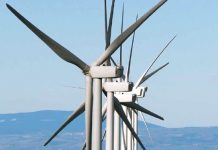Canada has reached the 10,000 MW milestone of installed wind energy capacity through the K2 Wind Power Project in southwestern Ontario and now has enough power to accommodate more than 3 million homes annually.
The Canadian Wind Energy Association recently announced that Canada’s wind energy industry has taken another significant leap forward. With the commissioning of the K2 Wind Power Project in southwestern Ontario in June, Canada has now become the seventh country in the world to surpass 10,000 MW of installed wind energy capacity.
 “Meeting the 10,000 MW milestone confirms that Canada is a global leader in wind energy development,” said Robert Hornung, president of CanWEA. “Wind energy’s cost competitiveness, coupled with the fact that it produces no greenhouse gas emissions, means it is well positioned to continue its rapid growth as a mainstream contributor to Canada’s electricity supply.”
“Meeting the 10,000 MW milestone confirms that Canada is a global leader in wind energy development,” said Robert Hornung, president of CanWEA. “Wind energy’s cost competitiveness, coupled with the fact that it produces no greenhouse gas emissions, means it is well positioned to continue its rapid growth as a mainstream contributor to Canada’s electricity supply.”
Over the last five years, more wind energy capacity has been installed in Canada than any other form of electricity generation. The nation has seen three record years for the annual installation of new wind energy capacity, and Canada’s wind energy capacity has grown by an average of 1,300 MW, or 24 percent, annually. Installations for 2015 are expected to exceed that average.
Wind turbines are now operating in every province in Canada, and in the Northwest Territories and Yukon, providing clean wind energy to over 100 communities and accounting for nearly 5 percent of domestic Canadian electricity demand. That’s enough power to meet the needs of over 3 million average Canadian homes every year.
“Wind energy is meeting Canada’s demand for new electricity in a clean, reliable and cost-competitive way,” Hornung said. “As concerns about global climate change grow, wind energy will also need to play a critical role in Canada’s transition to a more flexible and decentralized low carbon electricity system.
Every 100 MW of new wind energy brings 1,000 person-years of employment during the construction phase of a wind energy project and 350 person-years of work in long-term operations and maintenance. In addition, wind energy is delivering significant economic benefits to local economies through property tax payments, community benefit agreements and land lease contracts. Every megawatt of new wind energy represents an investment of approximately $2 million.
“We celebrate wind energy as Canada’s success story with another milestone reached,” Hornung said. “The best is yet to come.”
In celebration of the growing contribution that wind energy is making around the world and in Canada, CanWEA is once again proud to launch the annual Power of Wind contest. Students entering or who are in post-secondary education are eligible to submit entries on why harnessing wind power is important to Canada’s energy future. The submission deadline is September 16, and winners will be announced at CanWEA’s Annual Awards Banquet in Toronto on October 7. Additional information, contest rules, and terms and conditions can be found on the Friends of Wind website.
— Source: CanWEA



























